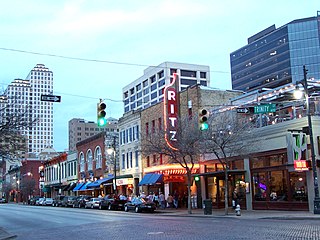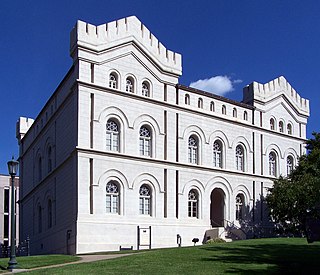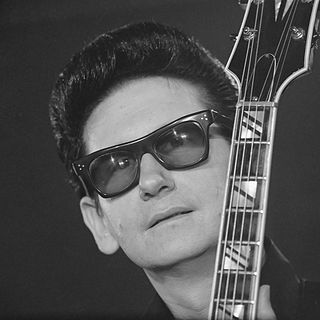
Ford's Theatre is a theatre located in Washington, D.C., which opened in August 1863. It is famous for being the site of the assassination of U.S. President Abraham Lincoln on April 14, 1865. After being shot, the fatally wounded 56-year old president was carried across the street to the Petersen House, where he died the next morning.

Starr Family Home State Historic Site is a 3.1-acre (1.3 ha) historical site operated by the Texas Historical Commission in downtown Marshall, Texas. It was listed on the National Register of Historic Places in 1979. The museum was made a Recorded Texas Historic Landmark in 1986. On January 1, 2008, the site was transferred from the Texas Parks and Wildlife Department to the Texas Historical Commission.

The Texas School Book Depository, now known as the Dallas County Administration Building, is a seven-floor building facing Dealey Plaza in Dallas, Texas. The building is most notable as the vantage point of the assassination of John F. Kennedy on November 22, 1963. Employee Lee Harvey Oswald shot and killed President Kennedy from a sixth floor window on the building's southeastern corner. The structure is a Recorded Texas Historic Landmark, located at 411 Elm Street on the northwest corner of Elm and North Houston Streets, at the western end of downtown Dallas.

Sixth Street is a historic street and entertainment district in Austin, Texas located within the city's urban core in Downtown Austin. Sixth Street was formerly named Pecan Street under Austin's older naming convention, which had east-west streets named after trees and north-south streets named after Texas rivers.

Fort Brown was a military post of the United States Army in Cameron County, Texas during the later half of the 19th century and the early part of the 20th century. Established in 1846, it was the first United States Army military outpost of the recently annexed state. Confederate Army troops stationed there saw action during the American Civil War. In the early 20th century, it was garrisoned in relation to military activity over border conflicts with Mexico. Surviving elements of the fort were designated as a National Historic Landmark in 1960.

The San Francisco Maritime National Historical Park is located in San Francisco, California, United States. The park includes a fleet of historic vessels, a visitor center, a maritime museum, and a library/research facility. The park used to be referred to as the San Francisco Maritime Museum, however the former 1951 name changed in 1978 when the collections were acquired by the National Park Service. Today's San Francisco Maritime National Historical Park was authorized in 1988; the maritime museum is among the park's many cultural resources. The park also incorporates the Aquatic Park Historic District, bounded by Van Ness Avenue, Polk Street, and Hyde Street.

The Altria Theater in Richmond, Virginia, United States is a theater at the southwest corner of Monroe Park, the largest venue of Richmond CenterStage's performing arts complex. Formerly known as The Mosque and the Landmark Theater, the Altria Theater was originally built for Shriners of the Acca Temple Shrine.

The Texas Theatre is a movie theater and Dallas Landmark located in the Oak Cliff neighborhood of Dallas, Texas. It gained historical significance on November 22, 1963 as the location of Lee Harvey Oswald's arrest for the killing of Dallas police officer J. D. Tippit. Today, it hosts a mix of repertory cinema and special events.

Harpers Ferry National Historical Park is located at the confluence of the Potomac and Shenandoah rivers in and around Harpers Ferry, West Virginia. The park includes land in the Shenandoah Valley in Jefferson County, West Virginia; Washington County, Maryland and Loudoun County, Virginia. The park is managed by the National Park Service, an agency of the U.S. Department of the Interior. Originally designated Harpers Ferry National Monument in 1944, the park was declared a National Historical Park by the U.S. Congress in 1963. The park includes the historic town of Harpers Ferry, notable as a center of 19th-century industry and as the scene of John Brown's failed abolitionist uprising. Consisting of almost 4,000 acres (16 km2), it includes the site of which Thomas Jefferson once wrote, "The passage of the Potomac through the Blue Ridge is perhaps one of the most stupendous scenes in Nature" after visiting the area in 1783. Due to a mixture of historical events and ample recreational opportunities, all within 50 miles (80 km) of Washington, D.C., the park was listed on the National Register of Historic Places on October 15, 1966. The Park's Superintendent is presently Tyrone Brandyburg.

The General Land Office Building, completed in 1857, in Austin, Texas is the oldest surviving state government office building in the city and the first building designed by a university-trained architect. The building features a dramatic medieval castle style known as Rundbogenstil, or "rounded arch" around the windows and doors. There is also a Norman style influence in the castle-like parapets. The exterior walls are limestone rubble smoothed over with stucco and scored to simulate cut stone blocks.

The Spanish Governor's Palace is a historic adobe from the Spanish Texas period located in Downtown San Antonio.

The Simon Theatre is a theater in Brenham, Texas. It was built by James Simon, designed by Houston architect Alfred C. Finn, and constructed in 1925. For many decades the Simon Theatre provided the community with a setting for theatrical performances, vaudeville acts, ballroom dances, special events and movies.

The Landmark Inn State Historic Site is a historic inn in Castroville, Texas, United States. It serves the general public as both a state historic site and a bed & breakfast with eight overnight rooms.

Sam Brown Memorial State Wayside is a historical park in Browns Valley, Minnesota, United States, established in 1929 to honor frontiersman Sam Brown (1845–1925). On April 19, 1866, Brown rode 55 miles (89 km) to warn other settlers of an impending attack by Native Americans, and when the threat proved false he rode back through a spring blizzard to intercept his dispatch to the U.S. Army, suffering injuries that left him in a wheelchair for the rest of his life.

Clements Hall, formerly known as Atkins Hall, is a historic building on the campus of Southern Methodist University in University Park, Texas, U.S.. It was built in 1915, and designed by Shepley, Rutan and Coolidge in the Georgian Revival architectural style. It has been listed on the National Register of Historic Places since September 27, 1980.

Snider Hall is a historic building on the campus of Southern Methodist University in University Park, Texas, U.S.. It was built in 1927, and designed by Wyatt C. Hedrick in the Georgian Revival architectural style. It has been listed on the National Register of Historic Places since September 27, 1980.























